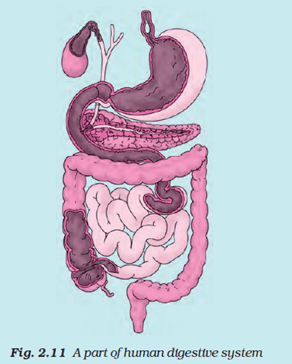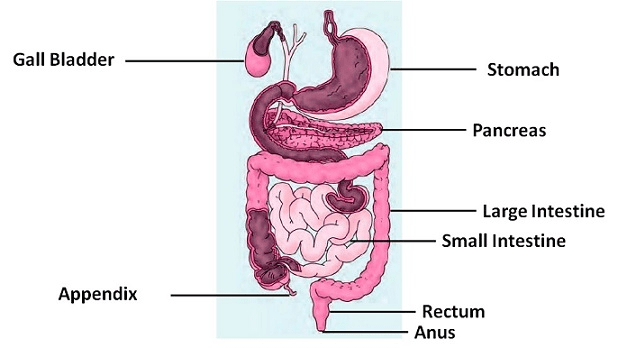NCERT solutions class 7 science Chapter 2 Nutrition in Animals is provided here to help students in understanding the topic thoroughly. All these solutions are solved by experts with a detailed explanation. Class 7 NCERT Solutions for Science Chapter 2 includes all the textbook exercise questions and answers. These solutions will help students complete their assignments & homework.
Having a good grasp over CBSE NCERT Solutions for Class 7 Science will further help the students in their preparation for board exams and other competitive exams. NCERT Solutions for Class 7 Science Chapter 2 Nutrition in Animals provided by CBSE Path help students to clear their doubts and to obtain good marks in the exams. All the solutions provided in this article are strictly based on the CBSE syllabus and curriculum.
Class 7 Science Nutrition in Animals Chapter 2 Questions and Answers
Exercise Questions
1. Fill in the blanks:
(a) The main steps of nutrition in humans are _________, __________, __________, _________ and __________.
(b) The largest gland in the human body is __________.
(c) The stomach releases hydrochloric acid and ___________ juices which act on food.
(d) The inner wall of the small intestine has many finger-like outgrowths called _________.
(e) Amoeba digests its food in the ____________ .
Answer:
(a) The main steps of nutrition in humans are ingestion, digestion, absorption, assimilation and egestion.
(b) The largest gland in the human body is Liver.
(c) The stomach releases hydrochloric acid and digestive juices which act on food.
(d) The inner wall of the small intestine has many finger-like outgrowths called villi.
(e) Amoeba digests its food in the food vacuole.
Question 2. Mark ‘T’ if the statement is true and ‘F’ if it is false:
(a) Digestion of starch starts in the stomach. (T/F
(b) The tongue helps in mixing food with saliva. (T/F)
(c) The gall bladder temporarily stores bile. (T/F)
(d) The ruminants bring back swallowed grass into their mouth and chew it for some time. (T/F)
Answer:
(a) False
(b) True
(c) True
(d) True
Question 3. Tick (✓) mark the correct answer in each of the following:
(a) Fat is completely digested in the
(i) stomach
(ii) mouth
(iii) small intestine
(iv) large intestine
Answer: (iii) Small intestine.
(b) Water from the undigested food is absorbed mainly in the
(i) stomach
(ii) foodpipe
(iii) small intestine
(iv) large intestine
Answer: (iv) Large intestine.
Question 4. Match the items of Column I with those given in Column II:
| Column- I | Column- II |
| Food components | Product(s) of digestion |
| Carbohydrates | Fatty acids and glycerol |
| Proteins | Sugar |
| Fats | Amino acids |
Answer:
| Column – I | Column – II |
| Food components | Product(s) of digestion |
| Carbohydrates | Sugar |
| Proteins | Amino acids |
| Fats | Fatty acids and glycerol |
Question 5: What are villi? What is their location and function?
Answer: Villi are tiny finger-like projections originating from the walls of the small intestine. They increase the surface area for absorption of the digested food. The blood vessels present inside the villi can absorb the nutrients from the digested food.
Question 6: Where is the bile produced? Which component of the food does it help to digest?
Answer: Liver secretes the bile juice which is stored in the gall bladder. Bile plays an important role in the digestion of fats.
Question 7: Name the type of carbohydrate that can be digested by ruminants but not by humans. Give the reason also.
Answer: Cellulose is the carbohydrate that can be digested by ruminants. Ruminants have large sac-like structure between the small intestine and large intestine. The cellulose of the food is digested by the action of certain bacteria which are not present in humans.
Question 8: Why do we get instant energy from glucose?
Answer: Glucose is a simple sugar which is easily absorbed by the blood whereas other carbohydrates are first broken down into glucose and then absorbed; hence, glucose gives instant energy.
Question 9. Which part of the digestive canal is involved in:
(i) Absorption of food ________ .
(ii) Chewing of food ________ .
(iii) Killing of bacteria ________ .
(iv) Complete digestion of food ________ .
(v) Formation of faeces ________ .
Answer:
(i) Small intestine
(ii) Mouth
(iii) Stomach
(iv) Small intestine
(v) Large intestine
Question 10: Write one similarity and one difference between the nutrition in amoeba and human beings.
Answer: Similarity: The digestive juices in amoeba are secreted into food vacuole and in human beings, the digestive juices are secreted in the stomach and small intestine. Then the juices convert complex food into simpler soluble and absorbable substances. ‘
Difference: Amoeba captures the food with the help of pseudopodia and engulfs it. In human beings food is taken by the mouth.
Question 11: Match the items of Column I with suitable items in Column II
| Column-I | Column-II |
| (a) Salivary gland | (i) Bile juice secretion |
| (b) Stomach | (ii) Storage of undigested food |
| (c) Liver | (iii) Saliva secretion |
| (d) Rectum | (iv) Acid release |
| (e) Small intestine | (v) Digestion is completed |
| (f) Large intestine | (vi) Absorption of water |
| (vii) Release of faeces |
Answer:
| Column-I | Column-II |
| (a) Salivary gland | (iii) Saliva secretion |
| (b) Stomach | (iv) Acid release |
| (c) Liver | (i) Bile juice secretion |
| (d) Rectum | (ii) Storage of undigested food |
| (e) Small intestine | (v) Digestion is completed |
| (f) Large intestine | (vi) Absorption of water |
Question 12: Label Fig. 2.11 of the digestive system.

Answer:

Question 13: Can we survive only on raw, leafy vegetables/grass? Discuss.
Answer: No, we cannot survive only on raw, leafy vegetables, or grass. It is because the grass is rich in cellulose, which is a type of carbohydrate that humans are not able to digest due to the absence of cellulose-digesting enzymes.